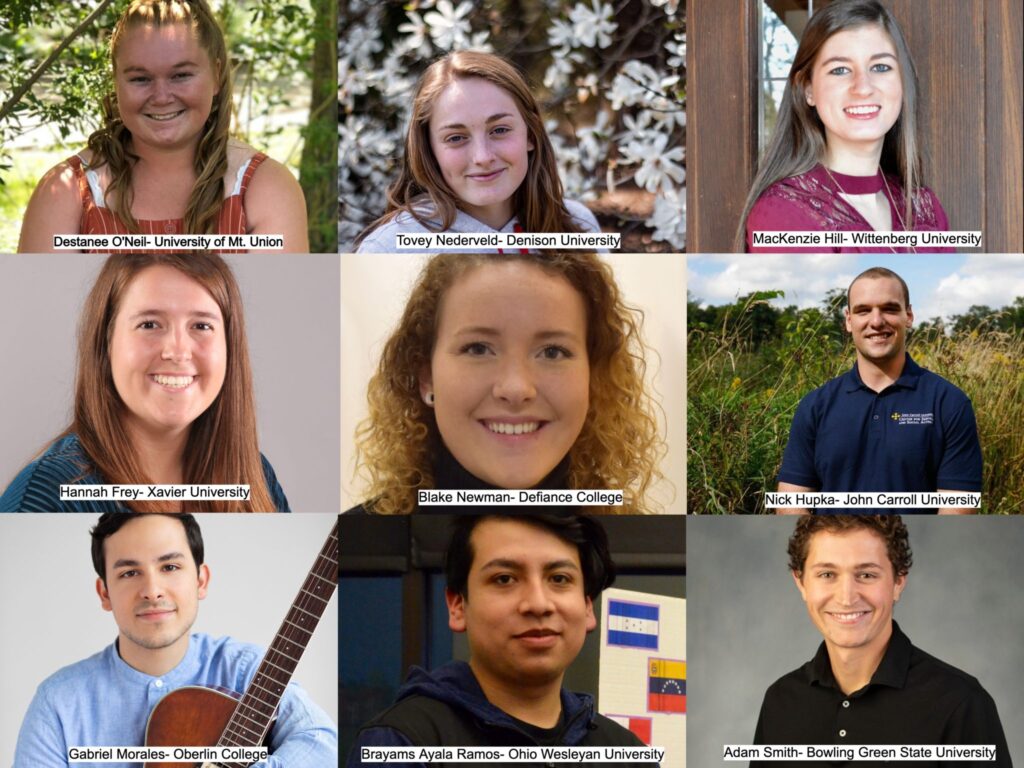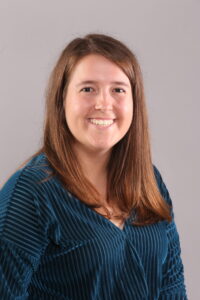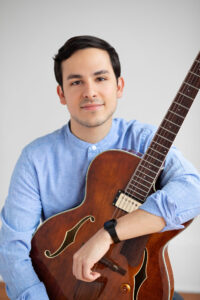Ohio Campus Compact is excited to announce nine Charles J. Ping Student Service Award Recipients for 2020!
OCC’s Charles J. Ping Student Service Award is designed to recognize and honor undergraduate students for their outstanding leadership and contributions to community service or service-learning on their campus and within their community. These students represent the next generation of civic leaders and problem solvers. The award is named in honor of Charles J. Ping, who served as President of Ohio University from 1975 – 1994. An early supporter and Board Member of Ohio Campus Compact, Ping has been a tireless advocate for campus-community partnerships and increased opportunities for students to become active and engaged citizens.
This recognition is granted annually to undergraduates at Ohio Campus Compact member institutions.
“Many students will participate in volunteerism or community service during college, and some will rise above and stand out in their leadership ability and compassion for others. Ohio Campus Compact is pleased to recognize nine compassionate leaders with the Charles J. Ping Student Service Award for 2020.” ~Richard Kinsley, Executive Director, Ohio Campus Compact
Students nominated to be a Charles J. Ping Student Service Award winner compete with other nominees from across the state for two $250 Legacy Award mini grants, to be given to a nonprofit organization of the winner’s choice. The Legacy Award mini grants are sponsored by Ohio Campus Compact.
Congratulations 2020 Charles J. Ping Student Service Award Recipients!

View all Ping Award essays here: 2020 PING BOOKLET
While all Ping awardees show exceptional leadership, initiative and innovation, OCC recognizes Hannah Frey and Gabriel Morales as the 2020 Legacy Award winners!

Hannah Frey, Xavier University
Class of 2020, Social Work and Psychology
Hannah’s essay: Staring down the clogged opening of an Elmer’s glue, frustration fills me as I try desperately to clear the opening. In desperation, I grab child’s size scissors hoping to stab a clearing for the glue to flow through. The scissors appear to still be too large. A group of 10 middle schoolers surround me at a table waiting somewhat patiently as I try to open the glue, but I know that any moment they could erupt into chaos. Exasperated, I’m about to give up when I hear this soft voice whisper, “Miss Hannah?” I turn to see where the voice came from and a girl is looking up at me and has clearly had a front row seat to my wrestling match with this glue. She smiles understandingly at me, reaches into her hijab, and pulls out a needle for me to use to poke a hole in the clogged glue. In the relief of solving this impossible problem, we both broke out into laughter at the ridiculousness of the situation. The whole point of this afterschool club of middle schoolers was to help foster creativity and this girl had demonstrated that creativity perfectly through her ability to come up with a simple solution to my seemingly impossible problem.
My friends and I had started this program for middle schoolers with the goal or re-stimulating their imaginations. With the growing dependence on technology, the younger generations have less of a need to use their imaginations to entertain themselves. In addition to this crisis of creativity, and due to my summer working at a nature preservation, we recognized the crisis of climate change. Therefore, we started a program that combine sustainable efforts with creative play called Imagination Foundation. An example of a project the students completed was when the students used cardboard, paper, markers, and other miscellaneous materials to create costumes for a Halloween fashion show. Not only did they build the outfits themselves, some of the students even collaborated to create a choreographed dance to music. In this moment, I realized that the students had truly tapped into their creative powers and made something unique and beautiful.
For many of these students, English was not their first language and quite a few were refugees from various countries. This space after school allowed them an outlet to express themselves freely that they might not have had naturally built into a school day. Through art and building, there was no need for language or communication and created a space of mutual exchange through expression. Now through my field placement, I see these same students thriving in high school. One of which wants to work at Artworks over the summer and ultimately to become a lawyer. While I would never pretend our once a week club has contributed a ton to her success, however I hope that in our time in Imagination Foundation she was able to see the magnificence of her creative abilities and carry that with her into her future endeavors.

Gabriel Morales, Oberlin College
Class of 2022, Jazz Guitar Performance
Early on in my time at Oberlin, I was unsure as to how I would balance my work in music studies and performance with some form of community service. I felt as if they would be conflicting interests, each taking time from the other. After discovering Oberlin Center for the Arts (OCA), my perspective on this issue drastically changed. As an organization, OCA centers on connecting students, educators, and the broader community to various forms of arts programming and other area arts organizations. After joining the OCA team, I was collecting data on the accessibility of various forms of arts programming for underserved populations, researching and creating arts-in-health programming, and hosting performances for area high school students by acclaimed artists such as Rhiannon Giddens. This work shed new light on the relationship between music and community because I found that, instead of conflicting, the two were informing each other. One of my main leadership achievements has been developing and implementing OCA’s Performing Artists In Residence (PAIR) program. In the fall of 2019, I began researching organizations in the U.S. that had arts programming for health spaces- ranging from hospitals to senior care facilities -and compiled potential opportunities to bring the arts into underserved health spaces in Oberlin. Connecting with Mercy Allen Hospital and Welcome Nursing Home, the OCA team and I developed a program model where musicians would give regular performances, either at a patient’s bedside or for small gatherings. These performances served the purpose of relieving stress, improving the atmosphere, offering comfort, and providing access to art that is often unavailable. Given the wealth of talent nearby, we recruited instrumentalists from Oberlin’s Conservatory for this program, and I gave performances as well. Musicians taking part in this program were given basic training for working in health spaces and prompted to reflect on each performance- the patient’s response, repertoire selected, and personal feelings, among other aspects. After a full semester of performances, it was clear that the patients and staff at the health facilities were delighted with the programming and eager to see it continue and expand. During my time engaging in community service learning, I discovered newfound importance in music and the arts’ connection to the broader community. Performing and creating programs for community members informed me of the importance of connecting to people from a service standpoint. Generally, we musicians tend to perform with the intention of, yes, giving ourselves to the audience but also receiving gratification. In service, the focus shifts to performing in a way that is perceptive of a patient’s needs and elevates their experience. Such work has also impacted fellow conservatory students because those who have participated see how removed we can often be from our immediate community and how easily we can positively impact people if we take consistent time to share our talent and enthusiasm. Overall, engaging in community service learning has shown me the importance of approaching both my music and community-oriented work as correlated and most beneficial when united.

